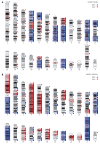Establishment and characterization of cell lines from chromosomal instable colorectal cancer
- PMID: 25574089
- PMCID: PMC4284332
- DOI: 10.3748/wjg.v21.i1.164
Establishment and characterization of cell lines from chromosomal instable colorectal cancer
Abstract
Aim: To generate novel tumor models for preclinical validation of biomarkers that allow drug response prediction and individual therapeutic decisions.
Methods: Cell line establishment was conducted by both direct in vitro culturing and in vivo xenografting followed by in vitro culturing procedure. A comprehensive characterization was subsequently performed. This included quality control, consisting of the confirmation of human and colorectal cancer (CRC) origin by DNA fingerprint and epithelial cell adhesion molecule (EpCAM) staining, as well as mycoplasma and human virus testing. Phenotypic analysis was done by light microscopy and multicolor flow cytometry. Histopathological examination (β-catenin and cytokeratin staining) was conducted in direct comparison to parental tumor tissues. Extensive molecular-pathological profiling included mutation analysis for CRC-associated driver mutations, assessment of chromosomal and microsatellite instability, and the grade of CpG island methylation. Additionally, an array-based comparative genomic hybridization analysis was performed. Drug responsiveness was assessed for a panel of classical and novel substances in clinical use for the treatment of solid cancers. Finally, tumorigenicity of the cell lines was tested by xenografting into immunocompromised nude mice.
Results: Herein we describe the establishment of three ultra-low passage cell lines from two individual patients suffering from sporadic CRC. One cell line was derived directly from an early stage case (HROC18), whereas two cell lines could be established both direct from patient material and after xenografting from a late stage tumor (HROC32). All cell lines were free of contaminating mycoplasma and viruses. Molecular-pathological analysis allowed all cell lines to be classified as chromosomal instable (CIN(+)). They were aneuploid, with CpG island promoter methylation and microsatellite instability being absent. The following mutational profile was observed both in the cell lines and the parental tumor tissue: HROC18: APC(mut), p53(mut), K-ras(wt); HROC32: APC(wt), p53(mut), K-ras(mut). All cell lines were characterized as epithelial (EpCAM(+)) cells, showing distinct morphology and migration speed, but comparable growth kinetics. The cell lines showed different patterns of response towards clinically approved and novel drugs, with HROC18 being more resistant than HROC32 cells. Finally, in vivo tumorigenicity was demonstrated.
Conclusion: We successfully established and characterized novel ultra-low passage patient-derived CRC models as useful instruments for analyzing biological characteristics associated with the CIN(+) phenotype.
Keywords: Colorectal cancer; Drug response; Individualized medicine; Molecular characterization; Patient-derived tumor model; Translational research.
Figures






Similar articles
-
Establishment, functional and genetic characterization of three novel patient-derived rectal cancer cell lines.World J Gastroenterol. 2018 Nov 21;24(43):4880-4892. doi: 10.3748/wjg.v24.i43.4880. World J Gastroenterol. 2018. PMID: 30487698 Free PMC article.
-
Establishment, functional and genetic characterization of a colon derived large cell neuroendocrine carcinoma cell line.World J Gastroenterol. 2018 Sep 7;24(33):3749-3759. doi: 10.3748/wjg.v24.i33.3749. World J Gastroenterol. 2018. PMID: 30197480 Free PMC article.
-
Functional Characterization and Drug Response of Freshly Established Patient-Derived Tumor Models with CpG Island Methylator Phenotype.PLoS One. 2015 Nov 30;10(11):e0143194. doi: 10.1371/journal.pone.0143194. eCollection 2015. PLoS One. 2015. PMID: 26618628 Free PMC article.
-
Clinical and molecular features of young-onset colorectal cancer.World J Gastroenterol. 2016 Feb 7;22(5):1736-44. doi: 10.3748/wjg.v22.i5.1736. World J Gastroenterol. 2016. PMID: 26855533 Free PMC article. Review.
-
Genetics and Genetic Biomarkers in Sporadic Colorectal Cancer.Gastroenterology. 2015 Oct;149(5):1177-1190.e3. doi: 10.1053/j.gastro.2015.06.047. Epub 2015 Jul 26. Gastroenterology. 2015. PMID: 26216840 Free PMC article. Review.
Cited by
-
β-catenin-independent regulation of Wnt target genes by RoR2 and ATF2/ATF4 in colon cancer cells.Sci Rep. 2018 Feb 16;8(1):3178. doi: 10.1038/s41598-018-20641-5. Sci Rep. 2018. PMID: 29453334 Free PMC article.
-
Establishment, functional and genetic characterization of three novel patient-derived rectal cancer cell lines.World J Gastroenterol. 2018 Nov 21;24(43):4880-4892. doi: 10.3748/wjg.v24.i43.4880. World J Gastroenterol. 2018. PMID: 30487698 Free PMC article.
-
Murine Endogenous Retroviruses Are Detectable in Patient-Derived Xenografts but Not in Patient-Individual Cell Lines of Human Colorectal Cancer.Front Microbiol. 2018 Apr 24;9:789. doi: 10.3389/fmicb.2018.00789. eCollection 2018. Front Microbiol. 2018. PMID: 29755432 Free PMC article.
-
The HROC-Xenobank-A High Quality Assured PDX Biobank of >100 Individual Colorectal Cancer Models.Cancers (Basel). 2021 Nov 23;13(23):5882. doi: 10.3390/cancers13235882. Cancers (Basel). 2021. PMID: 34884989 Free PMC article.
-
Reactivating p53 and Inducing Tumor Apoptosis (RITA) Enhances the Response of RITA-Sensitive Colorectal Cancer Cells to Chemotherapeutic Agents 5-Fluorouracil and Oxaliplatin.Neoplasia. 2017 Apr;19(4):301-309. doi: 10.1016/j.neo.2017.01.007. Epub 2017 Mar 9. Neoplasia. 2017. PMID: 28284059 Free PMC article.
References
-
- Vogelstein B, Fearon ER, Hamilton SR, Kern SE, Preisinger AC, Leppert M, Nakamura Y, White R, Smits AM, Bos JL. Genetic alterations during colorectal-tumor development. N Engl J Med. 1988;319:525–532. - PubMed
-
- Jass JR. Molecular heterogeneity of colorectal cancer: Implications for cancer control. Surg Oncol. 2007;16 Suppl 1:S7–S9. - PubMed
-
- Ostwald C, Linnebacher M, Weirich V, Prall F. Chromosomally and microsatellite stable colorectal carcinomas without the CpG island methylator phenotype in a molecular classification. Int J Oncol. 2009;35:321–327. - PubMed
-
- Jass JR. Classification of colorectal cancer based on correlation of clinical, morphological and molecular features. Histopathology. 2007;50:113–130. - PubMed
-
- Fearon ER, Vogelstein B. A genetic model for colorectal tumorigenesis. Cell. 1990;61:759–767. - PubMed
Publication types
MeSH terms
Substances
LinkOut - more resources
Full Text Sources
Other Literature Sources
Medical
Research Materials
Miscellaneous

